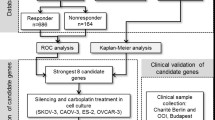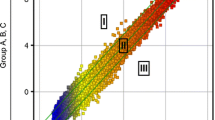Abstract
Purpose
To identify genes involved in the paclitaxel resistance phenotype.
Methods
High-density Affymetrix HG-U95Av2 microarrays were used to quantify gene expression in the resulting cell lines, SKOV-3TR, OVCAR8TR and MCF-7TR, and their drug-sensitive parental lines, SKOV-3, OVCAR8 and MCF-7.
Results
Three paclitaxel-resistant human ovarian and breast cancer cell lines were established. We identified 790 (SKOV-3TR), 689 (OVCAR8TR) and 964 (MCF-7TR) transcripts that were more than twofold overexpressed relative to their expression in the corresponding parental cell line. A comparison of these transcripts identified eight genes that were significantly overexpressed in all three drug-resistant daughter cell lines. These genes included MDR1, a gene often implicated in both in vitro and in vivo resistance to multiple chemotherapeutics, including paclitaxel. The remaining seven genes have not been previously associated with resistance to paclitaxel in human cancer. Furthermore, we identified 815 (SKOV-3TR), 430 (OVCAR8TR) and 332 (MCF-7TR) transcripts that were more than twofold decreased relative to their expression in the corresponding parental cell line. Comparison of these transcripts identified three genes that were significantly underexpressed in all three drug-resistant cell lines, none of which have been previously associated with paclitaxel resistance.
Conclusions
Our results confirm that the paclitaxel resistance phenotype is associated with a large number of transcriptional changes. In addition, acquired paclitaxel resistance was associated with distinct transcriptional changes in each of the cell lines studied, suggesting that paclitaxel resistance is a complex phenotype that can arise through multiple mechanisms.




Similar content being viewed by others
References
McGuire WP, Blessing JA, Moore D, Lentz SS, Photopulos G (1996) Paclitaxel has moderate activity in squamous cervix cancer. A Gynecologic Oncology Group study. J Clin Oncol 14:792
Loe DW, Deeley RG, Cole SP (1996) Biology of the multidrug resistance-associated protein, MRP. Eur J Cancer 32A:945
Volm M (1998) Multidrug resistance and its reversal. Anticancer Res 18:2905
Ferreira CG, Tolis C, Giaccone G (1999) p53 and chemosensitivity. Ann Oncol 10:1011
Lamendola DE, Duan Z, Yusuf RZ, Seiden MV (2003) Molecular description of evolving paclitaxel resistance in the SKOV-3 human ovarian carcinoma cell line. Cancer Res 63:2200
Watts GS, Futscher BW, Isett R, Gleason-Guzman M, Kunkel MW, Salmon SE (2001) cDNA microarray analysis of multidrug resistance: doxorubicin selection produces multiple defects in apoptosis signaling pathways. J Pharmacol Exp Ther 299:434
McGuire WP, Hoskins WJ, Brady MF, Kucera PR, Partridge EE, Look KY, Clarke-Pearson DL, Davidson M (1996) Cyclophosphamide and cisplatin compared with paclitaxel and cisplatin in patients with stage III and stage IV ovarian cancer. N Engl J Med 334:1
Brockstein B, Haraf DJ, Stenson K, Fasanmade A, Stupp R, Glisson B, Lippman SM, Ratain MJ, Sulzen L, Klepsch A, Weichselbaum RR, Vokes EE (1998) Phase I study of concomitant chemoradiotherapy with paclitaxel, fluorouracil, and hydroxyurea with granulocyte colony-stimulating factor support for patients with poor-prognosis cancer of the head and neck. J Clin Oncol 16:735
Dumontet C, Duran GE, Steger KA, Beketic-Oreskovic L, Sikic BI (1996) Resistance mechanisms in human sarcoma mutants derived by single-step exposure to paclitaxel (Taxol). Cancer Res 56:1091
Giannakakou P, Sackett DL, Kang YK, Zhan Z, Buters JT, Fojo T, Poruchynsky MS (1997) Paclitaxel-resistant human ovarian cancer cells have mutant beta-tubulins that exhibit impaired paclitaxel-driven polymerization. J Biol Chem 272:17118
Yusuf RZ, Duan Z, Lamendola DE, Penson RT, Seiden MV (2003) Paclitaxel resistance: molecular mechanisms and pharmacologic manipulation. Curr Cancer Drug Targets 3:1
Duan Z, Feller AJ, Penson RT, Chabner BA, Seiden MV (1999) Discovery of differentially expressed genes associated with paclitaxel resistance using cDNA array technology: analysis of interleukin (IL) 6, IL-8, and monocyte chemotactic protein 1 in the paclitaxel-resistant phenotype. Clin Cancer Res 5:3445
Duan Z, Feller AJ, Toh HC, Makastorsis T, Seiden MV (1999) TRAG-3, a novel gene, isolated from a taxol-resistant ovarian carcinoma cell line. Gene 229:75
Carmichael J, DeGraff WG, Gazdar AF, Minna JD, Mitchell JB (1987) Evaluation of a tetrazolium-based semiautomated colorimetric assay: assessment of radiosensitivity. Cancer Res 47:943
Duan Z, Lamendola DE, Penson RT, Kronish KM, Seiden MV (2002) Overexpression of IL-6 but not IL-8 increases paclitaxel resistance of U-2OS human osteosarcoma cells. Cytokine 17:234
Duan Z, Lamendola DE, Yusuf RZ, Penson RT, Preffer FI, Seiden MV (2002) Overexpression of human phosphoglycerate kinase 1 (PGK1) induces a multidrug resistance phenotype. Anticancer Res 22:1933
Duan Z, Duan Y, Lamendola DE, Yusuf RZ, Naeem R, Penson RT, Seiden MV (2003) Overexpression of MAGE/GAGE genes in paclitaxel/doxorubicin-resistant human cancer cell lines. Clin Cancer Res 9:2778
Dolci ED, Abramson R, Xuan Y, Siegfried J, Yuenger KA, Yassa DS, Tritton TR (1993) Anomalous expression of P-glycoprotein in highly drug-resistant human KB cells. Int J Cancer 54:302
Baird RD, Kaye SB (2003) Drug resistance reversal—are we getting closer? Eur J Cancer 39:2450
Penson R, Skates SJ, Glyptis T, Fuller AF, Goodman A, Seiden MV (2004) Expression of multidrug resistance-1 protein inversely correlates with paclitaxel response and survival in ovarian cancer patients: a study in serial samples. Gynecol Oncol 93:98
Seiden MV, Swenerton KD, Matulonis U, Campos S, Rose P, Batist G, Ette E, Garg V, Fuller A, Harding MW, Charpentier D (2002) A phase II study of the MDR inhibitor biricodar (INCEL, VX-710) and paclitaxel in women with advanced ovarian cancer refractory to paclitaxel therapy. Gynecol Oncol 86:302
Smith AJ, van Helvoort A, van Meer G, Szabo K, Welker E, Szakacs G, Varadi A, Sarkadi B, Borst P (2000) MDR3 P-glycoprotein, a phosphatidylcholine translocase, transports several cytotoxic drugs and directly interacts with drugs as judged by interference with nucleotide trapping. J Biol Chem 275:23530
Arai Y, Masuda M, Sugawara I, Arai T, Motoji T, Tsuruo T, Oshimi K, Mizoguchi H (1997) Expression of the MDR1 and MDR3 gene products in acute and chronic leukemias. Leuk Res 21:313
Shibata K, Kikkawa F, Nawa A, Suganuma N, Hamaguchi M (1997) Fibronectin secretion from human peritoneal tissue induces Mr 92,000 type IV collagenase expression and invasion in ovarian cancer cell lines. Cancer Res 57:5416
Vargas-Roig LM, Fanelli MA, Lopez LA, Gago FE, Tello O, Aznar JC, Ciocca DR (1997) Heat shock proteins and cell proliferation in human breast cancer biopsy samples. Cancer Detect Prev 21:441
Nylandsted J, Rohde M, Brand K, Bastholm L, Elling F, Jaattela M (2000) Selective depletion of heat shock protein 70 (Hsp70) activates a tumor-specific death program that is independent of caspases and bypasses Bcl-2. Proc Natl Acad Sci U S A 97:7871
Acknowledgement
This work was supported by NIH Grant CA 89150 (to M.V. Seiden).
Author information
Authors and Affiliations
Corresponding author
Rights and permissions
About this article
Cite this article
Duan, Z., Lamendola, D.E., Duan, Y. et al. Description of paclitaxel resistance-associated genes in ovarian and breast cancer cell lines. Cancer Chemother Pharmacol 55, 277–285 (2005). https://doi.org/10.1007/s00280-004-0878-y
Received:
Accepted:
Published:
Issue Date:
DOI: https://doi.org/10.1007/s00280-004-0878-y




